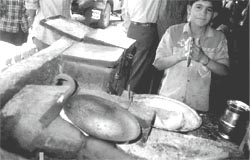Drought hit state
 Titanic sank not because it hit the iceberg, the reason for its sinking lies in its inability to take a turn on time'. These words are aptly used by Mahesh Bhat, the noted filmmaker, to describe the apathy of the government through his documentary Bearing the Brunt. The documentary was screened at the India International Centre annexee, New Delhi on 26th April and it portrays the drought conditions rampant in some parts of Rajasthan.
Titanic sank not because it hit the iceberg, the reason for its sinking lies in its inability to take a turn on time'. These words are aptly used by Mahesh Bhat, the noted filmmaker, to describe the apathy of the government through his documentary Bearing the Brunt. The documentary was screened at the India International Centre annexee, New Delhi on 26th April and it portrays the drought conditions rampant in some parts of Rajasthan.
The film has been conceptualised by Mahesh Bhatt, who conducted a soul-searching survey of the affected region before embarking upon this project. Lamenting lack of any sense of urgency in combating the drought situation in Rajasthan. Bhatt singled out procedural delays for the miserable condition of people in the wake of successive drought. These delays are simply killing people. He said, "the maximum brunt of the drought is being borne by the women and children. Children have been taken out of the schools as their parents have either migrated to cities in search of livelihood or can no longer afford the expenses to sustain the education of their children.
The film commissioned by Save the Children (sc), an international development organisation, is directed by Ajay Kanchan. The film predicts a grim summer for the people of Rajasthan and identifies unabated mining in ecologically sensitive areas like the Aravalli hills as the main reason for declining rainfall and recurrence of drought in the state. It says by putting greater emphasis on large projects like the Indira Gandhi Canal and laying pipelines for water supply in villages, the government has seriously compromised the traditional coping mechanisms of the people.
"Even as drought conditions became visible in July-August 1999, a crop assessment report was submitted only as late as in October, assessment of funds required was done in November and the central team visited the drought-hit areas in January 2000', said Ajay Kanchan, Filmmaker and activist from Savethe Children. Presenting his case study of last year's drought, Kanchan said, the state government sought a sum of Rs 1,145 crore but was granted only Rs 103 crore. The relief work started quite late and despite prevailing drought it ended abruptly. The state government claimed to have spent Rs 564 crore. But the ground reality was different, there was no relief work carried at all in some of the worst affected areas. As a result both people and the livestock suffered. "The only possible avenue for people is either to migrate or to seek employment in the mining industry that in turn is creating havoc in the surroundings and there is an environmental disaster in the making,' says Kanchan. The estimated crop loss during 2000-2001 runs into several crore rupees in 19 districts. In 1998-99, out of 32 districts of the state, 17 had been drought affected while in 1999-2000, the number of affected districts increased to 26 and in the present year 31 districts are affected by drought.
"The film is an attempt to sensitize and influence the government, media, ngos and the society at large about the situation of the drought- stricken people with special focus on children,' says Vijayalakshmi Arora, head, programme support unit, personnel communication, Save the Children, New Delhi. The suffering of these people started around the time when Orissa was devastated by a super cyclone. Then there were the West Bengal floods, and Rajasthan continued to suffer despite the worsening nature of the drought. The floods have now been followed by an earthquake in Gujarat and the people of Rajasthanstill continue to suffer. The people of western and southern Rajasthan are victims of a double tragedy. Some of those who had migrated to Gujarat in search of livelihood had to come back in the wake of the earthquake.
The film recommends amendment of the Famine Relief Code, minimisation of procedural delays in assessment of relief work and it calls for special provision for women and children. Drought mitigation requires greater focus towards the most vulnerable section of the population, it is not just about water, fodder and employment. It seeks constructionof watersheds, nadis and tankas in place of mega projects. The relief works should not be stopped before vulnerability analysis is done. It demands immediate ban on mining in the ecologically sensitive areas of the Aravalli hills because depletion of green cover results in deficient rainfall and repeated droughts in Rajasthan. The film also recommends an interface with the civil society so that both disaster preparedness and mitigation measures can become more effective.
Drought is a simmering disaster, it may not kill people instantly but the suffering in its wake cannot be less painful than the one we witness following any cyclone, floods, earthquake or any other natural calamity. Through this film Bhatt has made an effort to sensitise the masses about the extent of predicament brought about by drought conditions plus the negligience on the part of the authorities in taking proper action.
Related Content
- 2024 Disasters in Numbers
- European State of the Climate Report 2024
- State of the climate in Latin America and the Caribbean 2023
- State of the global climate 2023
- Women paying the cost of the climate crisis with their wombs: quantifying loss and damage faced by women battling drought, debt and migration
- 2023 Near East and North Africa regional overview of food security and nutrition: statistics and trends
